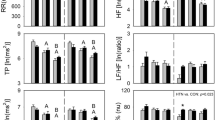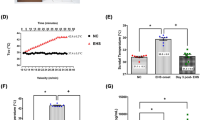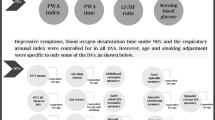Abstract
Chronic hypoxia is related to many pathological conditions: aging, heart and respiratory failure, sleep apneas, smoke, chronic obstructive pulmonary disease (COPD), diabetes, hypertension and arteriosclerosis, all characterized by reductions of sleep-related erections (SREs) and by erectile dysfunction (ED). Sleep-related erections occur naturally during rapid eye movement (REM) sleep in sexually potent men. Hypoxia is also a physiological condition at altitude. The level of inspired oxygen decreases progressively with the increase of altitude; for this reason, this study was performed to evaluate the relationship of SREs with hypoxic environment. SREs have been recorded by an erectometer (RigiScan) on three mountain climbers (mean age: 32.5) during a 26-day stay at an altitude ranging from 2000 to 5600 m above sea level. Twenty-four records have been made at progressively increasing altitudes. A data analysis was carried out on a statistical mean of the three values of each variable and an analysis of variance (ANOVA) and Newman–Keuls test were carried out for multiple comparison among groups. At altitudes over 4450 m, we found lack of rigidity at 80–100% and 60–79%. Mean % of rigidity and rigidity time of 80–100% (tip and base) decreased progressively with altitude. No significant reductions were shown in rigidity time at 0–19% and at 20–39% (tip and base), of total number, of total and mean duration of SREs. Pathological rigidometric records at high altitude in sexually potent men at sea level clarify the primary role of hypoxia in physiopathological ED pathway.
This is a preview of subscription content, access via your institution
Access options
Subscribe to this journal
Receive 8 print issues and online access
$259.00 per year
only $32.38 per issue
Buy this article
- Purchase on Springer Link
- Instant access to full article PDF
Prices may be subject to local taxes which are calculated during checkout





Similar content being viewed by others
References
Karacan I, Salis PJ, Hirshkowitz M, Borreson RE, Narter E, Williams RL . Erectile dysfunction in hypertensive men: sleep-related erections, penile blood flow, and musculovascular events. J Urol 1989; 142: 56–61.
Kim JJ, Moon DG, Koh SK . The role of nitric oxide in vivo feline erection under hypoxia. Int J Impot Res 1998; 10: 145–150.
Moreland RB . Is there a role of hypoxemia in penile fibrosis: a viewpoint presented to the Society for the Study of Impotence. Int J Impot Res 1998; 10: 113–120.
Sáenz de Tejada I, Angulo J, Cellek S, González-Cadavid N, Heaton J, Pickard R et al. Physiology of erection. J Sex Med 2004; 1: 254–265.
Steers WD . Neural pathways and central sites involved in penile erection: neuroanatomy and clinical implications. Neurosci Biobehav Rev 2000; 24: 507–516.
Sachs BD . Contextual approaches to the physiology and classification of erectile function, erectile dysfunction, and sexual arousal. Neurosci Biobehav Rev 2000; 24: 541–560.
Shabsigh R . Hypogonadism and erectile dysfunction: the role for testosterone therapy. Int J Impot Res 2003; 15 (Suppl 4): S9–S13.
Burnett AL . Nitric oxide in the penis: physiology and pathology. J Urol 1997; 157: 320–324.
Arnold WP, Mittal CK, Katsuki S, Murad F . Nitric oxide activates guanylate cyclase and increases guanosine 3:5-cyclic monophosphate levels in various tissues preparations. Proc Acad Natl Sci USA 1977; 74: 3203–3207.
Palmer RM, Moncada S . A novel citrulline-forming enzyme implicated in the formation of nitric oxide by vascular endothelial cells. Biochem Biophys Res Commun 1989; 158: 348–352.
Kwon NS, Nathan CF, Gilker C, Griffith OW, Matthews DE, Stuehr DJ . -citrulline production from L-arginine by macrophage nitric oxide synthase. The ureido oxygen derives from dioxygen. J Biol Chem 1990; 265: 13442–13445.
Hirshkowitz M, Schmidt MH . Sleep-related erections: clinical perspectives and neural mechanisms. Sleep Med Rev 2005; 9: 311–329.
Kim N, Vardi Y, Padma-Nathan H, Daley J, Goldstein I, Saenz de Tejada I . Oxygen tension regulates the nitric oxide pathway. Physiological role in penile erection. J Clin Invest 1993; 91: 437–442.
Kim N, Azadzoi KM, Goldstein I, Saenz de Tejada I . A nitric oxide-like factor mediates nonadrenergic–noncholinergic neurogenic relaxation of penile corpus cavernosum smooth muscle. J Clin Invest 1991; 88: 112–118.
Hansen J, Sander M, Hald CF, Victor RG, Thomas GD . Metabolic modulation of sympathetic vasoconstriction in human skeletal muscle: role of tissue hypoxia. J Physiol 2000; 527: 387–396.
Xie A, Skatrud JB, Puleo DS, Morgan BJ . Exposure to hypoxia produces long-lasting sympathetic activation in humans. J Appl Physiol 2001; 91: 1555–1562.
Rowell LB, Johnson DG, Chase PB, Comess KA, Seals DR . Hypoxemia raises muscle sympathetic activity but not norepinephrine in resting humans. J Appl Physiol 1989; 66: 1736–1743.
Antezana AM, Kacimi R, Le Trong JL, Marchal M, Abousahl I, Dubray C et al. Adrenergic status of humans during prolonged exposure to the altitude of 6,542 m. J Appl Physiol 1994; 76: 1055–1059.
Kanstrup IL, Poulsen TD, Hansen JM, Andersen LJ, Bestle MH, Christensen NJ et al. Blood pressure and plasma catecholamines in acute and prolonged hypoxia: effects of local hypothermia. J Appl Physiol 1999; 87: 2053–2058.
Peng Y, Kline DD, Dick TE, Prabhakar NR . Chronic intermittent hypoxia enhances carotid body chemoreceptor response to low oxygen. Adv Exp Med Biol 2001; 499: 33–38.
Parazzini F, Menchini Fabris F, Bortolotti A, Calabro A, Chatenoud L, Colli E et al. Frequency and determinants of erectile disfunction in Italy. Eur Urol 2000; 37: 43–49.
Hirshkowitz M, Karacan I, Arcasoy MO, Acik G, Narter EM, Williams RL . Prevalence of sleep apnea in men with erectile dysfunction. Urology 1990; 36: 232–234.
Feldman HA, Goldstein I, Hatzichristou DG, Krane RJ, McKinlay JB . Impotence and its medical and psychosocial correlates: results of the Massachusetts Male Aging Study. J Urol 1994; 151: 54–61.
Fletcher EC, Martin RJ . Sexual dysfunction and erectile impotence in chronic obstructive pulmonary disease. Chest 1982; 81: 413–421.
Karacan I, Hirshkowitz M . Aging and sleep apnea in impotent men with arterial risk factors. In: Smirne S, Franceschi M, Ferini-Strambi L (eds). Sleep and Ageing. Masson: Milano, 1991; 135–148.
Mizuno I, Fuse H, Fujiuchi Y, Nakagawa O, Akashi T . Comparative study between audiovisual sexual stimulation test and nocturnal penile tumescence test using RigiScan Plus in the evaluation of erectile dysfunction. Urol Int 2004; 72: 221–224.
Hatzichristou DG, Hatzimouratidis K, Ioannides E, Yannakoyorgos K, Dimitriadis G, Kalinderis A . Nocturnal penile tumescence and rigidity monitoring in young potent volunteers: reproducibility, evaluation criteria and the effect of sexual intercourse. J Urol 1998; 159: 1921–1926.
Acknowledgements
This work was partially supported by Professor R Tenaglia and C Di Giulio.
Author information
Authors and Affiliations
Corresponding author
Rights and permissions
About this article
Cite this article
Verratti, V., Di Giulio, C., Berardinelli, F. et al. The role of hypoxia in erectile dysfunction mechanisms. Int J Impot Res 19, 496–500 (2007). https://doi.org/10.1038/sj.ijir.3901560
Received:
Revised:
Accepted:
Published:
Issue Date:
DOI: https://doi.org/10.1038/sj.ijir.3901560
Keywords
This article is cited by
-
Impact of hypoxia on male reproductive functions
Molecular and Cellular Biochemistry (2023)
-
Addressing male sexual and reproductive health in the wake of COVID-19 outbreak
Journal of Endocrinological Investigation (2021)
-
Association between chronic obstructive pulmonary disease and risk of erectile dysfunction: a systematic review and meta-analysis
International Journal of Impotence Research (2020)
-
A pulse wave monitoring system based on a respiratory pacemaker
Network Modeling Analysis in Health Informatics and Bioinformatics (2017)
-
Chronic Rhinosinusitis Associated with Erectile Dysfunction: A Population-Based Study
Scientific Reports (2016)



